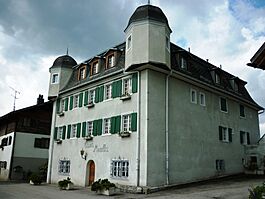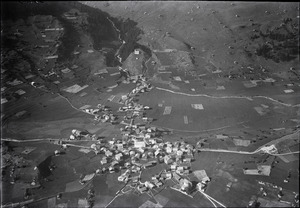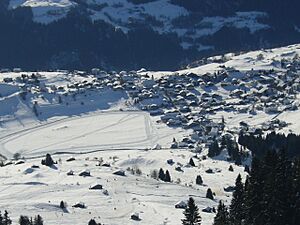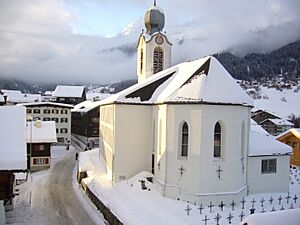Breil/Brigels facts for kids
Quick facts for kids
Breil/Brigels
|
||
|---|---|---|

Casa Mirella in Breil/Brigels
|
||
|
||
| Country | Switzerland | |
| Canton | Graubünden | |
| District | Surselva | |
| Area | ||
| • Total | 50.64 km2 (19.55 sq mi) | |
| Elevation | 1,280 m (4,200 ft) | |
| Population
(Dec 2020 )
|
||
| • Total | 11,253 | |
| • Density | 222.22/km2 (575.54/sq mi) | |
| Postal code |
7165
|
|
| Surrounded by | Linthal (GL), Obersaxen, Schlans, Trun, Waltensburg/Vuorz | |
| Twin towns | Gammelshausen (Germany) | |
Breil/Brigels is a town in the Surselva Region in the Swiss canton of Graubünden. It's a place where people live and work together. On January 1, 2018, the towns of Andiast and Waltensburg/Vuorz joined with Breil/Brigels.
The name of the town comes from an old word, brigilo, which means little town. The name is different in the two local languages. In Romansh, it's called Breil [bʁɔjl]. In German, it's called Brigels German: [ˈbʁiːɡəls].
Contents
History of Breil/Brigels
People started living in this area a very long time ago, around the late Roman era or Early Middle Ages. Breil/Brigels was first mentioned in a record from the year 765. This was when the Bishop of Chur gave a farm in Breil/Brigels to Disentis Abbey, which was a type of monastery.
Soon after, the Abbey built a church and a small fort on St. Eusebius' hill. The village church of S. Maria and the chapel of S. Sievi also came under the Abbey's control in 1185. This was ordered by the Pope.
In the early 1300s, the Abbot (the head of the Abbey) tried to get more control over the valley. But he was forced out in 1327. Later, in 1387, a big fire destroyed much of the Abbey. To pay for rebuilding, the Abbot sold some of his mountain pastures in Breil/Brigels.
In 1491, the village church of S. Maria became a main parish church. Then, in 1496, the Abbey church and fort on St. Eusebius' hill burned down and were never rebuilt.
The town faced tough times with the plague. In 1550, 316 people died. Six years later, the plague returned, killing 180 more. In 1631, another 130 people died. In 1738, the village no longer had to pay tithes (a type of tax) to the church.
Geography and Nature
Breil/Brigels covers an area of about 50.8 square kilometers (about 19.6 square miles). A big part of this land, about 35%, is used for farming. Forests cover about 23.5% of the area.
About 2.4% of the land has buildings or roads. The rest, about 38.9%, is made up of non-productive areas like rivers, glaciers, or mountains.
The town of Breil/Brigels is built on a flat area (a terrace) north of the Vorderrhein valley. It also includes smaller villages called hamlets. These are Dardin-Capeder (Dardin), which is below the main village, and Danis-Tavanasa (Danis, Tavanasa), which is on the valley floor. Before 1943, the town was just known as Brigels.
People of Breil/Brigels
Breil/Brigels has a population of about 1,187 people. A small part of the population, about 4.7%, are people from other countries. Over the last 10 years, the number of people living here has stayed about the same.
In 2000, there were slightly more males (50.6%) than females (49.4%).
- About 12.2% of the population were children aged 0-9.
- About 14.1% were teenagers aged 10-19.
- Adults aged 20-59 made up about 48% of the population.
- Seniors aged 60 and above made up about 26% of the population.
Most people in Switzerland are well-educated. In Breil/Brigels, about 61.6% of adults (aged 25-64) have finished high school or gone on to higher education like university.
The unemployment rate in Breil/Brigels is low, at about 1.14%. Many people work in different areas:
- About 90 people work in farming.
- About 108 people work in manufacturing or construction.
- About 280 people work in services like tourism, shops, or healthcare.
Here's how the population has changed over time:
| year | population |
|---|---|
| 1850 | 1,086 |
| 1888 | 848 |
| 1900 | 859 |
| 1910 | 1,033 |
| 1950 | 1,169 |
| 1960 | 1,272 |
| 2000 | 1,187 |
Languages Spoken
Most people in Breil/Brigels speak Sursilvan Romansh. In 2000, about 80.5% of the people spoke it. German is the second most common language (14.3%), and Italian is third (1.5%).
Religion
In 2000, most people in Breil/Brigels were Roman Catholic, about 88%. About 4.8% belonged to the Swiss Reformed Church. A small number of people belonged to other Christian churches or were Islamic. Some people did not belong to any church.
The Protestant Reformation, a big change in Christian beliefs, did not become popular in Breil/Brigels. This was because of the strong influence of the nearby Disentis Abbey.
Important Heritage Sites
The Chaplutta Son Sievi (Chapel of Saint Sievi) is a very important historical site in Switzerland. It is listed as a national heritage site.
Transportation
Breil/Brigels has two train stations: Waltensburg/Vuorz and Tavanasa-Breil/Brigels. These stations are on the train line that connects to Disentis/Mustér and Scuol-Tarasp. Trains run regularly, making it easy to travel to and from the town.
See also
 In Spanish: Breil/Brigels para niños
In Spanish: Breil/Brigels para niños









